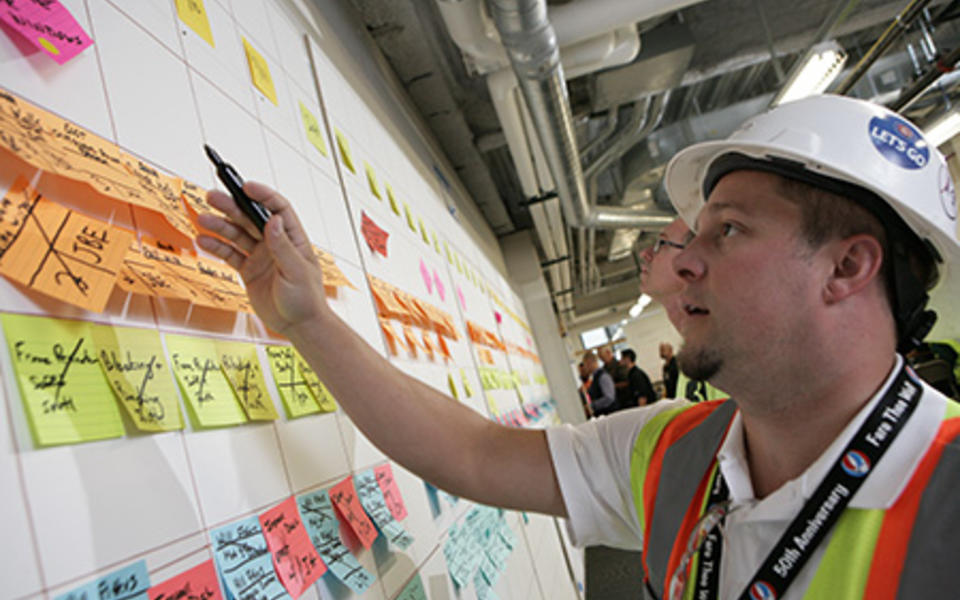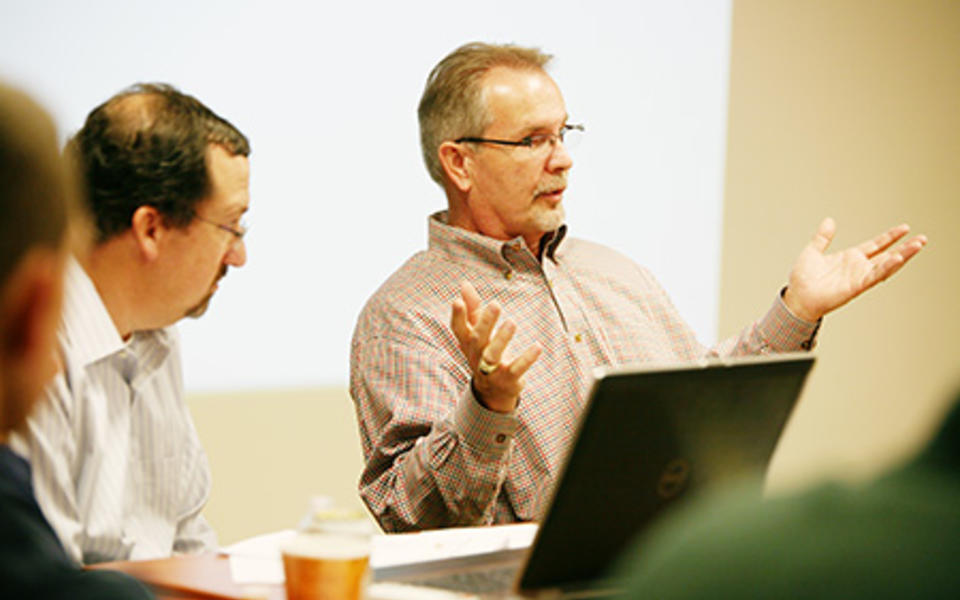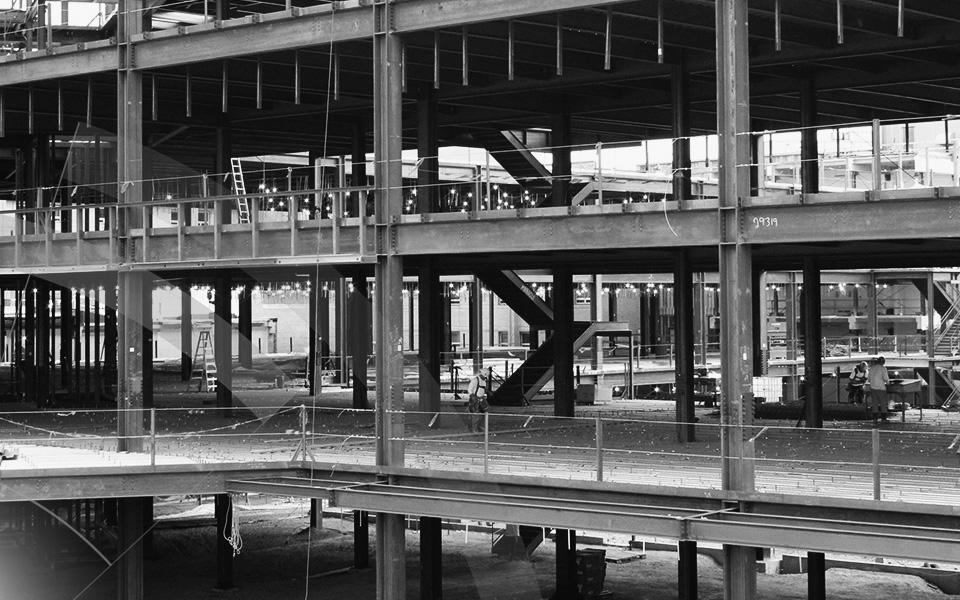Hanzo Logistics Headquarters & WarehouseIndustrial and manufacturing, Lean Construction, Quality
The triple constraint, or three-sided triangle of quality, schedule and budget that we seek to balance in construction, often leaves us with choices. In distribution, our clients don't have time to slow down, and they need the most cost-effective facility to compete…So does that leave quality with the short straw? Ignore quality altogether, and you shorten the life of your building, not to mention your equipment from the wear-and-tear of a poorly-constructed facility.
Building owners have learned where quality matters most and have cut out the nonessential upfront, providing little room for contractors to make up schedule delays or find savings when unforeseen conditions arise. This was true for Hanzo Logistics, which specializes in warehouse management, fulfillment and distribution and transportation for several different customers. In 2014, Pepper built their current headquarters and distribution center in Plainfield, Indiana, and within the first year they were ready to expand their capacity. We broke ground in June 2015 on the new addition. And then the rain came – a total of 26 inches from June to August that put the project nearly a month behind schedule, a significant amount of time considering the overall project schedule was only five months.
Through a combination of lean principles, quality control measures and solid relationships, the project concluded with all three sides of the triangle still intact – on time, within budget and one of the flattest floors Pepper has installed to date.
A lean perspective
At the beginning of the project, Pepper developed a project-specific lean plan, where the team decided to implement the following activities: defining client values, pull planning with percent plan complete, daily huddles, 5-S plan, increased visualization and trade contractor involvement. When conditions on site changed, the plan became even more relevant in helping the team recover, and three specific tools were especially effective in facilitating the turnaround.
Back to grade school - gold-star pull planning and percent plan complete
For those who haven't bought into the sticky-note program yet, this team found the pull planning process to be very effective at compressing and managing the schedule. The team adapted the process to work with the style of the partners on the project. As the superintendent describes, it was facilitated as more of a push/pull plan, where Pepper's team provided direction and pushed the subs to pull it back.
They posted the schedule on the wall six weeks at a time. The schedule showed what was going on each day and who was on site. Those who accomplished the work that was scheduled for each day were rewarded with gold stars on their sticky-notes, and their progress was logged on the percent plan complete chart. The stars were intended to hold people accountable and help Pepper keep track, and it also turned into something even more effective – motivation and competition to see who could get the most stars.
"When the foremen have a good attitude about it [pull planning], they can use it like any other tool. It helps them plan their work/manpower, coordinate with others, make sure they’re out of the way of the trade coming behind them, and so on," explains Superintendent Paul Pritchard.
For example, through the pull planning process, the team decided to switch the order of the slab pours and pour the floor slab where the bathrooms are located first, before any of the other slabs on the project. They determined that if the original sequence was followed, they would have only two weeks to complete the build-out work (walls, plumbing, electrical, etc.) The new sequence gave them more time - closer to a month to complete the work.
Spit shine saves nine
The 5-S Plan was used for logistic planning and onsite coordination. As the schedule was further compressed, the site organization became critical to ensuring contractors had enough space and safe conditions to get their work done. The plan addressed:
- Sort – determined the materials on site and construction activities taking place at a given time
- Set – planned for where materials would go and where each trade partner would be working
- Shine – strategically placed dumpsters for efficient cleaning
- Standardize – enforced the plan for materials staging and work taking place
- Sustain – reviewed the plan weekly to hold trades accountable
This plan came into play as trades were asked to find ways to meet in the middle to accomplish the overall project goals. It ensured them that they would not be working on top of someone else or be crowded by the next trade, and it allowed them to offer their own solutions for gaining efficiencies on the project.
Seeing is believing
The third lean tool that helped facilitate project efficiencies was Increased Visualization. The schedule and percent plan complete chart were part of this visual communication. Other posted documents included the safety standards and logistics phasing plans. Even a weather station was mounted on the trailer and gave real-time read outs of weather conditions including rain fall, rain rate, humidity and temperature, and the team was able to chart the weather over a long period of time.
This information worked well for foremen, but the team realized that only those who came into the jobsite trailer saw the plans. They wanted to do more – to place information on the jobsite where every person could see the plan and how their daily work contributed to the end result.
The superintendent created a visual board that was located close to the entrance, in a spot that was both visible and out of the way. On it, they announced major upcoming milestones such as roofing, concrete pours and lighting. They also posted photos, a drawing of the project showing parking and deliveries and the safety scores of each contractor.
The word of the day is… useful
The communication board was a useful source of information, right where the work was taking place, and the team personalized the communication board not only to the project, but also to the work they were performing. When it came time to pour the floors, the superintendent developed a color-coded sequence. Each pour was assigned a different colored ribbon, and the key was added to the communication board. Then, ribbons were tied to the columns in the building to mark off where each pour started and stopped. It allowed the crews to set up their materials away from the areas that were being poured without walking back and forth between the plans and the jobsite, and it also allowed them to work more efficiently, knowing exactly where to start and stop with a quick glance up instead of breaking to reference documents.
QUALITY - PROVEN PROCESSES
So, how did we deal with all of that rain? How most projects today deal with it – through lime stabilization. Once the site was dried out, the weather turned in our favor. No more rain, which allowed us to create a very compacted and flat sub-grade – the secret under a flat floor. Some would consider us lucky; after all, you can't control the weather. But it's also been said that luck is what happens when preparation meets opportunity. And here's how we were prepared:
The right people in the right place at the right time
When it comes to quality, industrial owners are most concerned about the floor. Pepper's installation process is well planned and highly orchestrated because an error or oversight at any step could mean a deficiency in the final floor. The project manager at Hanzo Logistics developed our process, which is used on all of our projects. The goal is preventing and controlling cracking that may occur, and it has been so effective that we have virtually eliminated all cracking. Most importantly, we've eliminated the cracking where it counts the most – at the docks.
Our team spent time going through the details and developing a step by step plan, even before we began foundations. Not allowing enough time between pours, and the concrete doesn't have time to cure. Make the trucks wait too long onsite, and the consistency of the concrete changes.
Two weeks before slab preparation, we held a pre-installation conference where we included everyone involved in the process, from our form work team, the place/finish contractor, form work crew, ready-mix supplier, concrete hardener/sealer contractor and structural engineer. We covered every detail of the process, from how we would check sub-grade elevation, how we would form each pour, the sequence of pours, routing of concrete trucks and logistics, how long a truck could set before we turn it away, our process for slump testing on site and the FF and FL requirements. We even created a contingency plan if a batch plant were to go down.
The work itself began with moisture control to get the site as dry and compacted as possible. The slab preparation followed the roof to keep the slab dry at all times. During slab preparation, we verified the elevation of each layer. Then we placed and finished the concrete, tested the quality of our pours and added the saw cuts and hardening formula. This sequence was done one pour at a time, one day at a time. At Hanzo, there were eight pours that spanned approximately two weeks. In addition to the slabs, Pepper also applied a separate and even more detailed pour sequence at the docks.
Simple wins that build success
Pepper's lean process and our quality control measures helped us gain back some time without sacrificing the integrity of the building. Typically, this kind of savings comes at a cost, which we couldn't afford. Instead, our team used a personal approach to limit the amount of additional cost and also make up the remaining time. They looked at the critical path and identified activities that would make the biggest difference. Then, instead of making a big request of one key player, they broke the areas into bite-size pieces that individual contractors could swallow. Instead of accelerating activities by a week, could they make up two days – or even one?
If everyone could make up a couple of days, the time would snowball and add up to real savings. Instead of making demands, they asked what contractors would be willing to do to get the work done sooner. Would they be willing to put in a little overtime if it meant they could finish the job and move on to the next one without having to come back? Particularly for those out of town, it was more convenient to finish while they were already here. And several offered to do so, on their own, because it put them in a better position. We understood that the weather didn't just impact our project; it impacted our subcontractors' entire workload and created a domino effect, where they now had to consider all of their projects and how they would get all of them done.
By looking out for everyone, we finished the precast in six days instead of nine, the site work was completed over the weekends and the contractors rallied together to get the project done. Even with the advances in technology and new methodologies, construction remains a craft, and our team's approach allowed the workers to tap into the pride they have in their work.
Results
The results are impressive. The project was completed on time and on budget, despite losing nearly a month from rain. Further, our team celebrated one of the flattest floors we have achieved to date, with an average of FF 78.3 / FL 53.3 (compared to minimum requirement of FF 50 / FL 30).
When companies in our industry refer to themselves as relationship contractors, often they back this claim with some kind of statistic about the amount of repeat work they do. We've talked about ourselves in this way. However, our ability to secure work based on our existing relationships is not a direct benefit to our clients, and it's not our real motivation behind this approach. What brings value to our clients is how we seek to understand and treat those on our team in order to accomplish the goals – and it starts with our own team members. The relationship between the project manager and superintendent was especially collaborative on the Hanzo Logistics project.
"We were truly a team on this job," explained Paul. "I never once felt like I had to pull Sam along, and I hope he never felt that way about me… I think I did everything he needed me to do and vice versa. That was a major factor in the project success."
When we get outside of our own perspective and look for the win for the other guy, instead of pitting schedule, quality and cost against each other, we've found it's possible to achieve all three.










